Scandals of Classic Hollywood: Dorothy Dandridge vs. The World
by Anne Helen Petersen
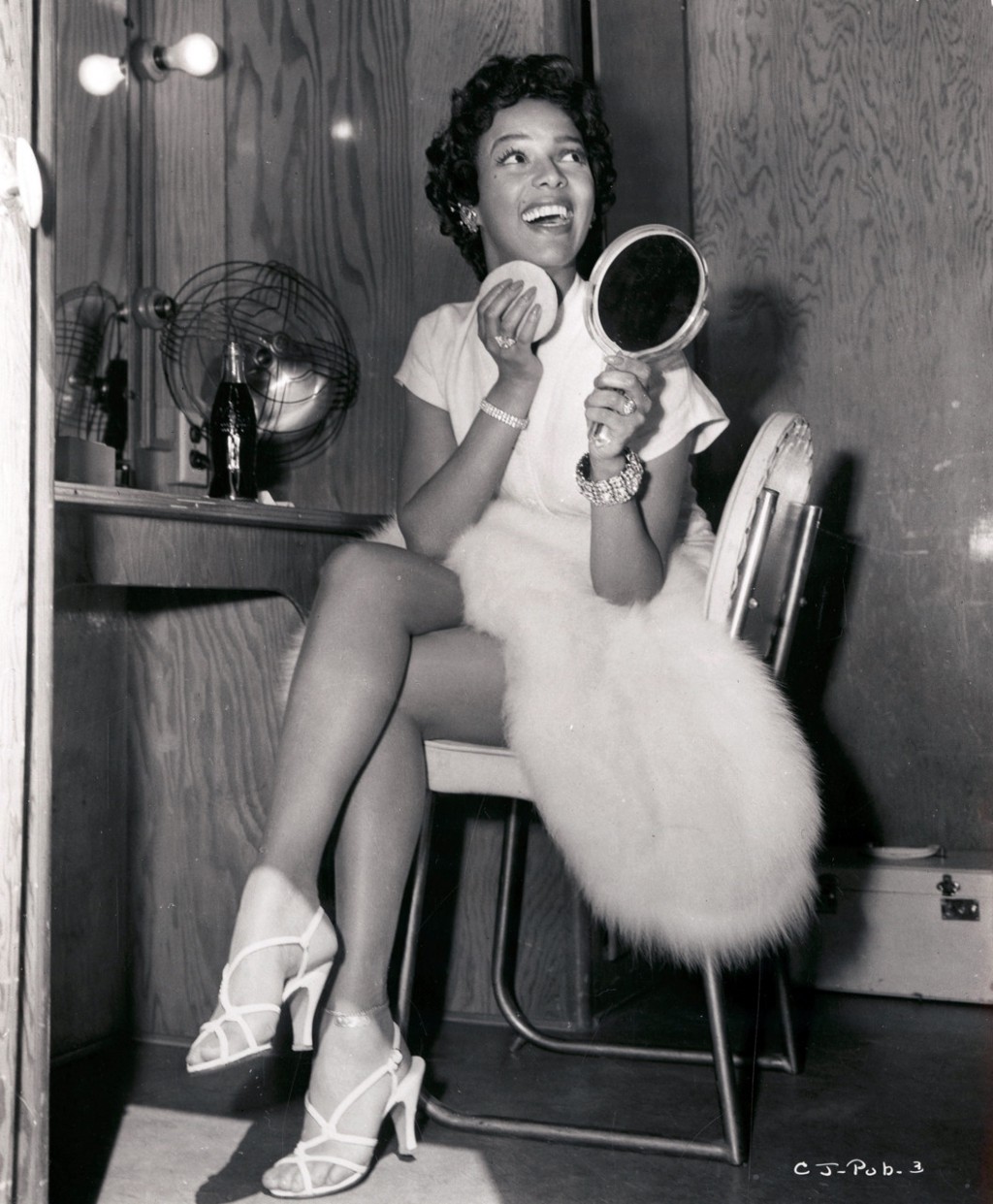
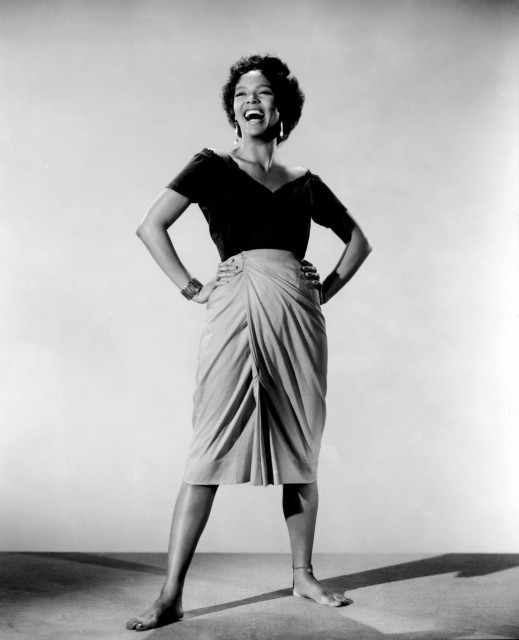
Dorothy Dandridge was a fighter. Growing up in The Depression and making her way through Hollywood in the ’40s, she encountered resistance — to her skin color, to her refusal to play demeaning roles — at every turn. She was assailed in the press for dating white men, and blamed herself for her husband’s philandering and her daughter’s brain damage. Nearly every societal convention was against her. And yet she managed to make a handful of gorgeous, invigorating films — films that offer a glimpse at the superstar she would have become if the studios knew what to do with with a beautiful black woman.
Her beauty was indeed phenomenal. She was called “the black Marilyn Monroe” and had flawless, radiant skin the black press referred to as “honey” and “cafe au lait.” And there was the certain way she took ownership of a room, with a reverberating, confident laugh and fierce, dazzling eyes. But being a black actor in the 1950s meant playing savages, slaves, and mamies — debasing roles that Dandridge refused on principle. In the films where she did get to play a a non-servant, non-exotic, non-savage, she was not allowed to do more than kiss, as the idea of a black woman in love was altogether too dangerous for the screen. “If I were white,” Dandridge explained, “I would capture the world.”
Dandridge was born in 1922 to Ruby Dandridge, a performer and aspiring actress. Ruby had left Dorothy’s father five months before, taking her other daughter, Vivian, with her. Both girls showed some sort of aptitude for performance — or maybe that aptitude was drilled into them — and one of Ruby’s friends, a woman named Geneva, moved in to help refine their singing and dancing skills. Years later, Dorothy and Vivian would figure out that Geneva was much more than her mother’s friend, but at the moment, she simply made them practice until they collapsed. Think wrist slaps and tears.
The girls became an act — “The Wonder Children” — and earned a spot with the National Baptist Convention touring churches throughout the South. This went on for three years, which sounds like a whole lot of churching, but Dorothy and Vivian no longer looked exactly like “children.” They added another girl, Etta Jones, to the act and became “The Dandridge Sisters,” touring all over California and eventually landing a gig at The Cotton Club. In short, the Dandridge girls spent their youth being corrected by their exacting stage mother, performing for church ladies, and receiving little to no schooling.
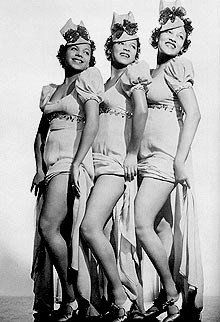
The Cotton Club gig turned into a slew of New York gigs, but Ruby had found moderate success with bit parts in Hollywood, so she sent the Exacting Lesbian Lover Geneva with her daughters to live in New York. Awesome plan. At this point, Dorothy was 16 — and now that you’ve seen the photos of her as an adult, you can only imagine how gorgeous she was at 16. In New York, she catches the eye of Harold Nicolas, one half of the snappy Nicolas Brothers Dancing Team. But The Dandridge Sisters were becoming a big draw, and Geneva signed them up for a European Tour. Farewell Harold, Farewell Teen Love. Except wait: World War II is about to turn everything to shit! Tour is cut short! Dandridge Sisters return to Hollywood! And guess who’s there making films: Nicolas Brothers!
Dorothy resumes her romance and lands a bit part in the race film Four Shall Die. (“Race” films, like “race” music, meant “black art for black people.”) She earned a very small part “opposite” (read: in the same movie as) John Wayne, and, most entertainingly, got to sing and dance with her boyfriend and his brother in a rendition of “Chattanooga Choo Choo” in Sun Valley Serenade.
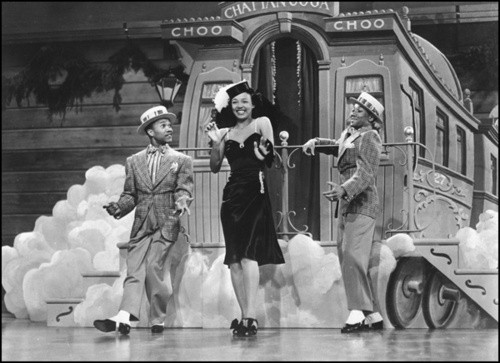
If you’re still unconvinced about Dandridge’s spark, watch this clip and you’ll believe:
At some point during this period, the Dandridge Sisters split up Destiny’s Child-style so that Dorothy can concentrate on her own career. But to truly pull away from Ruby and Geneva, Dorothy had to do something even more drastic: get married.
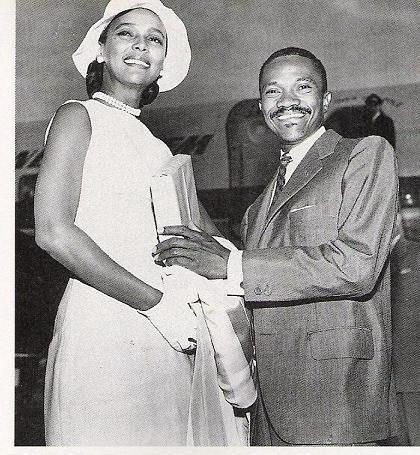
Dandridge and The Dancing Harold were married in September 1942, and all seemed well. No more Geneva-beatings, just domestic bliss and Hollywood bit-parts. Only Harold starts philandering all over the place, opting for long tours away from home. Dandridge blames herself — and her lack of sexual experience — for his wandering eye. Feminist digression: PATRIARCHY IS SUCH A DICK. Dandridge becomes pregnant in hopes of roping Harold back home, but we don’t need an Ask a Dude column to know how that strategy would turn out. A daughter, Lynn, is born in 1943.
But as Lynn grows, Dandridge realizes that something isn’t right. Lynn isn’t speaking; she isn’t responding. Doctors can’t seem to agree on what was going on, and with Nicolas constantly on the road, Dandridge is in shambles. Eventually, Lynn is diagnosed with brain damage — probably due to a lack of oxygen during delivery — but Dandridge blames herself. She eventually starts seeing a therapist, and by 1949, fed up with lousy Harold, she asks for a divorce.
Enter Dorothy Dandridge 2.0. With the help of song arranger Phil Moore, she crafts a new image for herself: less dancy-dancy, more smoldering-sultry. Despite her antipathy for the new club scene, she recognizes it as a stepping stone to a studio contract. Dandridge performs all over the States, but despises Vegas, which, at this point, is newly ascendant and filled with Rat Packers. Even hundreds of miles from the South and Jim Crow, the racism is appalling — following her act, Dandridge is “forbidden” from speaking with any of the audience, and cannot use the elevator, the hotel lobby, the swimming pool, even the bathrooms. Her dressing room was a mother-f-ing storage space. I’m so embarrassed for the people who made and enforced those rules, and fear what rules our grandchildren will shame us for. (Easy guess: how long it took to accept gay marriage. That or Nickelback.)
The offers for bit parts started to float in, but to get back on the big screen, Dandridge had to compromise her standards, agreeing to play “jungle queen” in Tarzan’s Peril. If you’re wondering why Dandridge was up in arms about specific roles, the explanation is somewhat simple. Apart from race films, the studios only cast black actors in:
1.) The “roles” they played in many white people’s lives, aka servants. Nannies, butlers, farm workers, train porters. In fact, black people are all over classic cinema — they’re just never onscreen for more than a minute, and they’re given accents and sayings that slot them into easy stereotypes. The overweight (and thus desexualized) mamie, the elderly (and thus desexualized) butler. Hattie McDaniel’s turn in Gone with the Wind and Bo Jangles’ pairings with Shirley Temple. (Note: the only reason Shirley Temple was allowed to be “alone” onscreen with a black man was because she was a child and he was elderly).
2.) “Exotic” roles that associate the black man/woman with the jungle, the animal, and the destructively sexual. Usually these characters die, because in the moral algebra of Hollywood, sex = death.
You can see why black actors would get fed up with these options. But tension remained: should black actors take demeaning, stereotypical roles if it meant that they could work? And that black faces showed up on screen? But weren’t those appearances perpetuating the cultural understandings that kept blacks subjugated to these roles onscreen and off? It’s a Catch-22. And if you’ve read any of the discourse surrounding the roles of gay actors and actresses in the 1990s and early 2000s — or, for that matter, any minority group that has been stereotyped and subjugated onscreen — than you know it’s not unique.
But that’s where Dandridge found herself in the early ’50s, and the tension between making a living and lifting up her race would structure the rest of her short career.
During this same period, Dandridge began to really blow up the club scene. She opened at The Mocambo in Hollywood, the type of place where all the Hollywood stars went to get blasted before “club” meant “filled with the smell of Axe Body Spray.” From there, she booked gigs all over New York, in Paris, on television, and became the first black woman to perform at the Waldorf Astoria. Girl was hot shit. Her act was more overtly sexual than her contemporary Lena Horne, who was, at this point, super pissed at Hollywood for casting Ava Gardner in the role she made famous in Showboat.
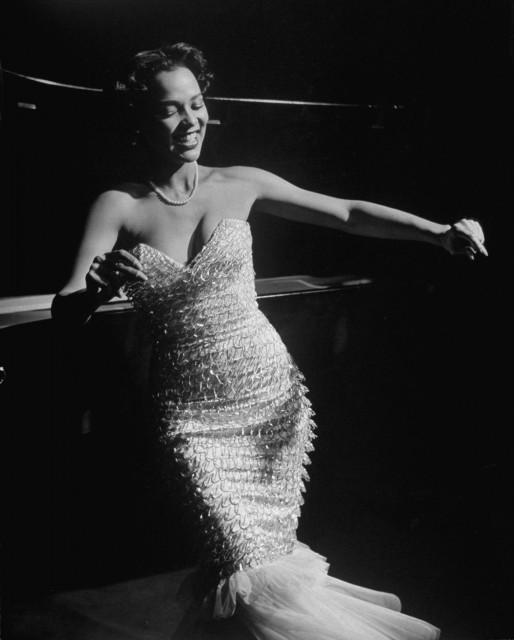
Club owners were quick to exploit Dandridge’s sexual edge — one purportedly even sold Kinsey’s Sexual Behavior of the the Human Female to promote her upcoming performances. Dandridge came to resent this sort of hyper-sexualization and hated how it opened doors for her that remained closed to other black formers. “Ella Fitzgerald is one of the most talented people in the world,” she once told a friend, “and it ebarrasses me that she cannot work the rooms that I work. She’s not sexy. The men in the audience don’t want to take her home and go to bed with her. Yet she’s up there singing her heart out for one third the money they’re paying me.”
But the sexy nightclub appearances won Dandridge the type of role for which she had been waiting: the lead in MGM’s all-black production of Bright Road, based on a young schoolteacher’s life in the South, and opposite Harry Belafonte.
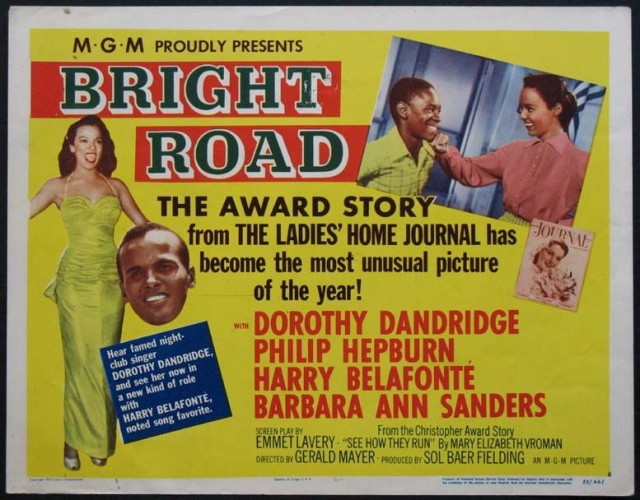
Let’s talk about the weirdness going on in this poster: is Dandridge punching that child in the face? Why is Belafonte’s decoupaged head floating? What does it mean to be a “noted song favorite?” And Ladies Home Journal, what praise! “Unusual!” Is that code for “Belafonte made us feel funny things in our bathing suit parts and we had to cross our legs?” The Ladies Home Journal un-endorsement helped Bright Road win the dubious distinction of “the lowest box-office gross in the South.”
20th Century Fox nevertheless snatched Dandridge up for a three-picture contract, and she went about lobbying for her true dream role: the lead in an all-black production of Carmen Jones (a film adaptation of the WWII stage musical, which was an adaptation of the classic opera Carmen, which was an adaptation of the novella Prosper Mérimée). Whew.
Fox slotted Otto Preminger to direct, which brings us to UNCEREMONIOIUS BREAK FOR FILM HISTORY LESSON:
Preminger had risen to prominence with a slew of noir-flavored films in the ’40s. In 1943, Preminger was coming off of The Moon is Blue, which, with its “lighthearted” treatment of an affair (read: people having sex don’t die or end in poverty), had violated the Hays Code and pissed off the Hollywood censorship. When Preminger and the studio behind the film, United Artists, refused to modify the script during production, the censorship board refused to grant it the Production Code “seal of approval.” (United Artists was the hippest studio in the 1950s. It wasn’t a studio so much as a production company, but you can read all about it in Tino Balio’s amazing history.)
If United Artists would have tried this stunt even ten years before, no seal would have meant no distribution. (Kind of like what happens when a film earns an NC-17 today. Sure, it’s “legal,” but few theaters will carry it). But UA saw that the moral climate — and tolerance and hunger for more explicit treatments of sex and relationships — had changed, and said fuck it, let’s give it a try. They open The Moon is Blue in a few urban markets, and its success convinces three major theater chains to distribute nationwide. But uptight Ohio, Kansas, and Maryland up and ban the film. Typical.
And here’s where it gets good: Preminger and United Artists realize they had a chance to potentially blow the entire Code out of the water. They sue the Maryland’s state censorship board, and a state Supreme Court judge overturns the ban, famously referring to the film as “a light comedy telling a tale of wide-eyed, brash, puppy-like innocence.” In other words: untwist your panties, state of Maryland. So far so good, so UA tries the same thing in Kansas, but no luck. Stay stodgy, Kansas. But UA says fuck it yet again: might as well go big or go home. They take the case to The Supreme Court, which overturns the Kansas ruling. No more banning of flirtly seduction films!
Paired with the ruling in “The Miracle Case” — when the Supreme Court declared censorship of Roberto Rosselinni’s film The Miracle as a violation of The First Amendment — The Moon is Blue significantly weakened the power of The Hays Code, which, in the decade to come, would dissolve altogether.
Point being: Preminger was the kind of man who tolerated little in the way of bullshit. He thought that black actors were woefully underused, and wanted to make the most of the tremendous talent he saw on the lot. Thus, Carmen Jones.
The story of Dandridge’s attempt to win the part of Carmen has morphed into the stuff of legend, which is another way of saying that half of it is probably bull. But here goes:
Dandridge wanted to prove herself as a serious actor, not a sex-bomb club performer. So when she went to see Preminger for the part, she wore “a navy-blue dress with a white Peter Pan collar. It fit through the waist, then flared. Her hair was pulled back in a ponytail.” Very Charlotte York of you, Dorothy.
But Preminger thought she was way too “high fashion.” As he purportedly told Dandridge, “this Carmen is an earthy girl who’s entirely different from you. Every time I look at you, I see Saks Fifth Avenue.”
Dandridge huffs and puffs out of there. Cut to montage of russling through her closet, hemming her skirts shorter, putting on black eyeliner. When she came back, she walked in with “tousled hair, dark makeup, a tight skirt, revealing blouse, and the sexiest swinging hips in town.”
She sounds like she’s wearing the Halloween costume of a harlot, but bygones. Preminger obviously gave her the part. And at some point in there — before or after, it’s unclear — Dandridge also made him his favorite dinner of cold steak and cucumber salad… CUT SCENE.
Thus began a tumultuous, open-secret of a relationship that would span the next several years.
The year to follow was the best of Dandridge’s career. She was once again paired with Harry Belafonte, only this time he got to wear a uniform. Now, you may only know the older, arch, raspy voice Belafonte (the one who endorses Obama and calls out the American government in Spike Lee’s When the Levees Broke — I love him so much). But young Belafonte, sweet lord, he was smokin’.
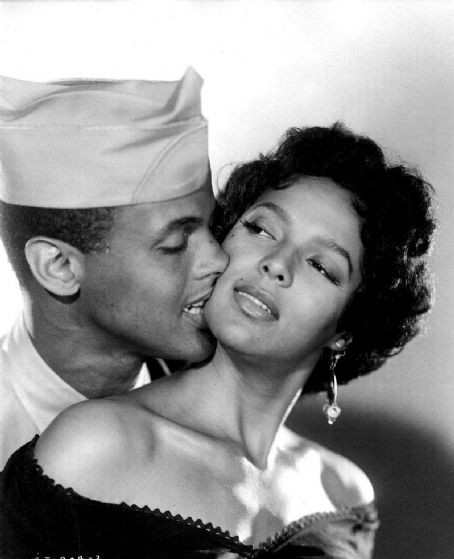
In what would become Dandridge’s signature outfit, she made the cover of Life — the first black woman to do so.
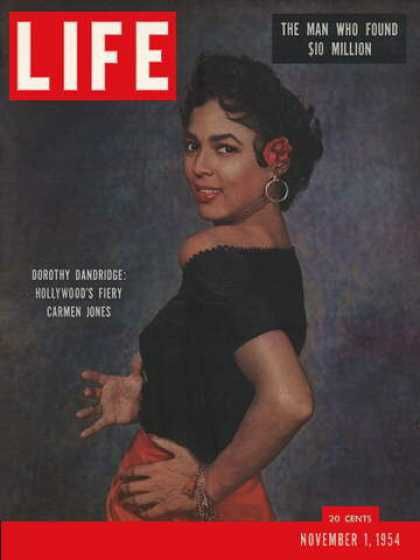
If looking that good on the cover of a national magazine wasn’t enough, she got to wear this incredible tube-top pants-suit inside the magazine:
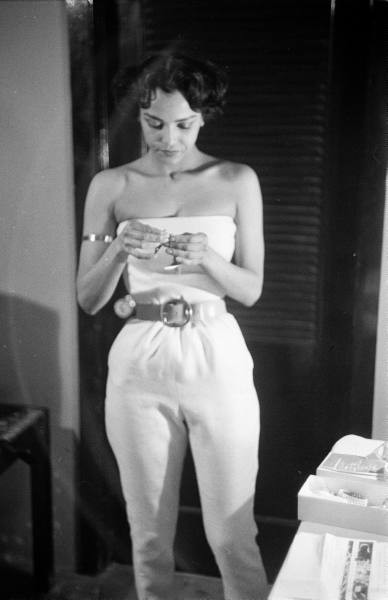
And the arm cuff! Hailing Jane: I want!
Meanwhile, the black gossip press wondered, with good cause, if Hollywood would actually “let negroes make love onscreen.” (On the grand scale of magazine headline weirdness, this cover rates an 11).
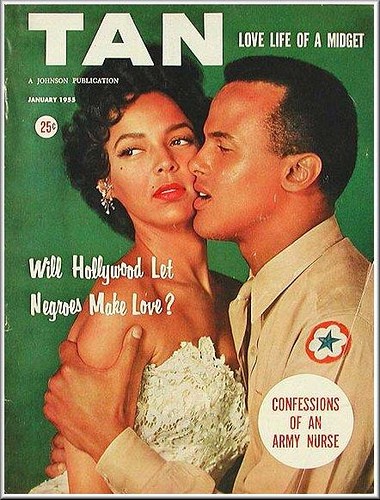
But Carmen Jones was a monster hit, which is code for “even white people went to see it.” Dandridge was nominated for an Academy Award — the first black woman to be nominated for Best Actress. And will you look at her competition: Judy Garland in A Star is Born, Audrey Hepburn in Sabrina, Jane Wyman in Magnificent Obsession, and Grace Kelly in The Country Girl. Dandridge lost to Kelly, but if you’ve seen The Country Girl, and you watch this clip below, you can see what the Academy was missing:
(Fastforward to 5:35)
“You make sounds I don’t like!” I LOVE HER SO MUCH. And that red skirt, holy shit: Jane, I beseech you.
You might note, however, that the singing voice doesn’t seem to emerge from Dandridge’s mouth. It didn’t. Both she and Belafonte were dubbed throughout due to the “un-opera-like” quality of their otherwise strong (read: black) voices. The film’s success stemmed from this combination of low-and-high, black-and-white: an all-black cast mapped upon the whitest of art forms. (In close competition: knitting, stain-glass, weaving).
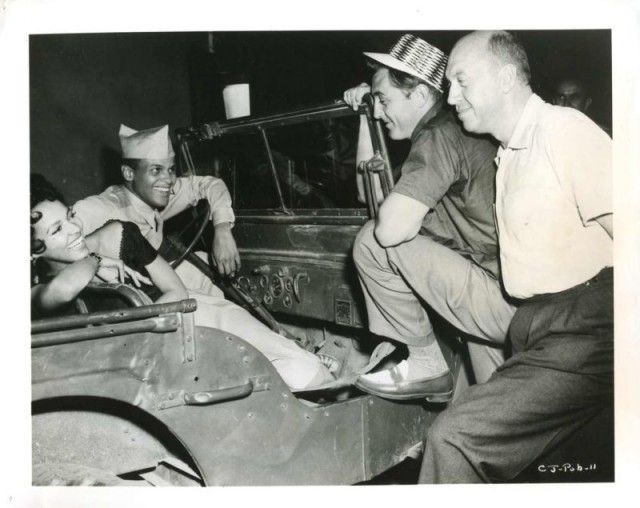
Bonus picture of Dandridge, Belafonte, Preminger — but why is Robert Mitchum hanging around?
Suddenly, everything was awesome. Dandridge could ask $100,000 a picture, draped herself in white beaver (weird?), bought a huge Hollywood mansion, and drove around town in a huge white Thunderbird. She accompanied Preminger to Cannes and waited for the offers to pour in.
A big one arrived: the role of Tuptim in The King and I. The film was going to be a huge production, and the role, while supporting, would’ve been high profile. But Tuptim was a slave, and after consulting with Preminger, Dandridge refused, certain that more offers would be forthcoming. The role went to Rita Moreno; the film was a smash. Dandridge had lost the momentum, and would later view the refusal of Tuptim as the beginning of her fall from grace.
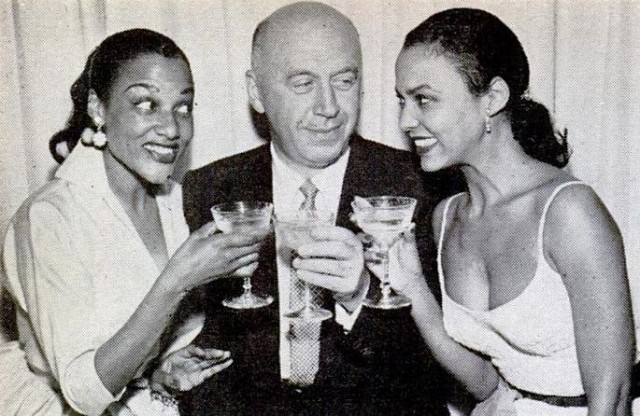
Preminger looking grade-A skeezy with the Dandridge sisters
Still waiting for a role, Dandridge’s relationship with Preminger became strained. In part because he was, well, married, but also because they couldn’t appear together in public unless they were promoting a film. At some point, Dandridge became pregnant, but had an abortion to avoid scandal. The press began linking her a list of white stars: Peter Lawford, Tyrone Power, Michael Rennie, Farley Granger Jr. Dandridge was, indeed, dating some, but certainly not all, of these men. As her sister Vivian later explained, she wasn’t dating white men because she was “prejudiced” against black men, as some press outlets alleged. Dandridge “would have been very happy to have married someone like a Harry Belafonte or a Sidney Poitier. But those men were already married. [Dorothy] just didn’t meet Black men in her world.”
Anxiety over Dandridge dating “out of race” popped up in, you guessed it, Confidential, which went for some good ol’ fashioned miscegenation fear-mongering, publishing a story on “What Dorothy Dandridge Did in the Woods.” (Read: Had Sex With a White Person.)
By this point, Dandridge was fed up. She filed suit against Confidential, testifying at the “Trial of 100 Stars” that attempted to take down the smut-rag. (The story behind the trial is fascinating and crucial to the future of the gossip industry; see Mary Desjardins’ article in Headline Hollywood.
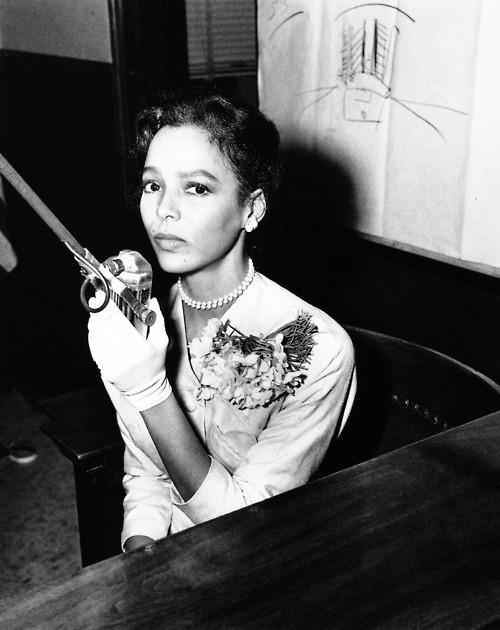
One very pissed off Dandridge testifying against Confidential
And still, Dandridge waited for a role. Recall, she was still under contract to Fox — which still wanted to make her a star. The problem, of course, mirrored that of her private life: they couldn’t find a way to put her onscreen with a white man. Finally, Fox cast her in Island in the Sun — a controversial script, set in the West Indies, that paired Dandridge, a “restless” bank clerk, with (white) John Justin, a governor’s aid, and low-class Harry Belafonte with (white) high-class Joan Fontaine.
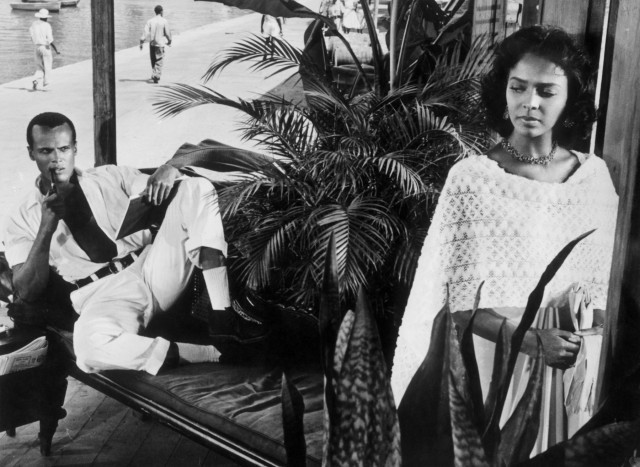
I could show you the clip of somewhat creepy John Justin but I couldn’t pass up another chance to show you Belafonte.
Fox exploited the controversy over the couplings into a demi-hit, yet Dandridge complained that there was no “intimacy” in what was meant to be a “love scene” between her and Justin. Think Julia Roberts and Denzel in The Pelican Brief — that sort of staid yearning. But it was also Dandridge’s first appearance on screen for nearly three years. The momentum was indeed lost.
Two small, unremarkable films followed (Tamango, The Decks Ran Red). Dandridge was increasingly desperate. So in 1959, she took the lead in Samuel Goldwyn’s production of Porgy and Bess. Big role! Awesome! Not so much: the characters of the well-known play were straight-up black stereotypes. Porgy’s a drunk, Bess is a drug addict, and other black characters are rapists and ne’er-do-wells. Belafonte was offered the role of Porgy, refused it on principle, and encouraged Dandridge to do the same. But Dandridge was still haunted by her decision to turn down The King and I, and took the role, alongside Sidney Poitier and Sammy Davis Jr.
And when Preminger, now quite estranged from Dandridge, stepped in to replace the director, everything went to hell. Already known for his harsh manner on set, Preminger brought Dandridge to tears on a regular basis. Think of it this way: you’re desperate for work, so take an embarrassing-yet-high-paying job. It’s okay, you think, I’ll be fine — at least I’ve got some hot and funny guys working with me. But then your just-fine, normal boss is replaced by your dick ex-boyfriend, and he shames you in front of your new co-workers constantly. That is the shit that Dandridge had to tolerate.
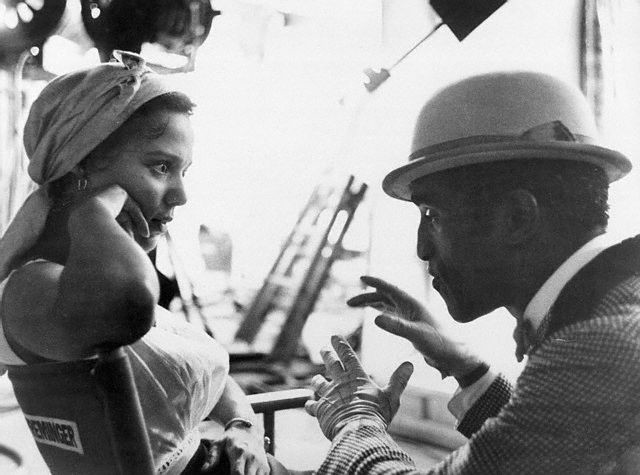
Despite claims that Porgy and Bess would “introduce a new era in motion pictures,” the film was a flop. Dandridge received a Golden Globe nomination for Best Actress, but in those days, Golden Globes were serious farm league.
And the unraveling begins. Dandridge meets Jack Denison, a true juicebox of a restaurant owner, and falls for his promises. They marry in June 1959, and he forces her to perform at his small-fry restaurant, effectively driving down her value with every appearance. He starts managing her career, beats her regularly, and loses a significant amount of her money. The other chunk of her money had been tucked away in what Dandridge thought to be a solid, fool-proof oil investment, but when it proves a massive scam, Dandridge and a dozen other stars lose everything.
Dandridge begins to drink heavily. No longer able to afford her daughter’s personal care, she’s forced to put her in a state mental home. She declares bankruptcy and takes piecemeal, embarrassing gigs to pay the bills. After a few years of terribleness, she ditches the juicebox, puts her life back together, and decides to make a second go — booking international club appearances and beginning rehearsals. But it was all very Michael Jackson preparing for the “This Is It” tour. She injured her foot while practicing, re-lost the momentum, and fatally overdosed — accidentally or purposefully — on her anti-depressant.
The year was 1965. Dorothy Dandridge was 42 years old. She had $2.14 in her bank account.
In the end, Hollywood forced her to embody one of the stereotypes she so loathed: the tragic mulatta, a woman accepted in some ways by both the black and white communities but rejected in other, crucial, heartbreaking ways. The white community loved her “white” beauty and the specter of her sexuality, but refused to allow her to actually act on that sexuality. Think early Britney Spears: be sexual, but don’t do anything with it. And if you do, you’re a slut.
Dandridge saw this clearly. “America was not geared to make me into a Liz Taylor, Monroe, or a Gardner,” she explained. “My sex symbolism was as a wanton, a prostitute, not as a woman seeking love and a husband, like other women.” Dandridge wasn’t the last black actress to be treated this way. Even today, Race-that-is-not-white + Sexualty = Something incendiary, something dangerous.
Dandridge suffered so that others wouldn’t have to. Yet fifty years after her death, when one would hope that all vestiges of discrimination, prejudice, and sexual stereotyping would have dissipated, they’re still alive, however quiet. Think of (mainstream) black female stars. There’s not a lot of them, so this won’t take you long. Now think about who they’re allowed to be with onscreen, and the discourses about their sexuality off-screen. Whitney Houston could do little more than kiss Kevin Costner in The Bodyguard. Halle Berry was archly criticized for taking a role in which she was hyper-sexualized and can’t open a movie. Viola Davis, Octavia Spencer, Jennifer Hudson, Mon’ique — none of them can get a leading role in a major Hollywood picture, much less a romantic leading role. We may have a black president, but most Americans still don’t know what to do with a black, sexual woman onscreen.
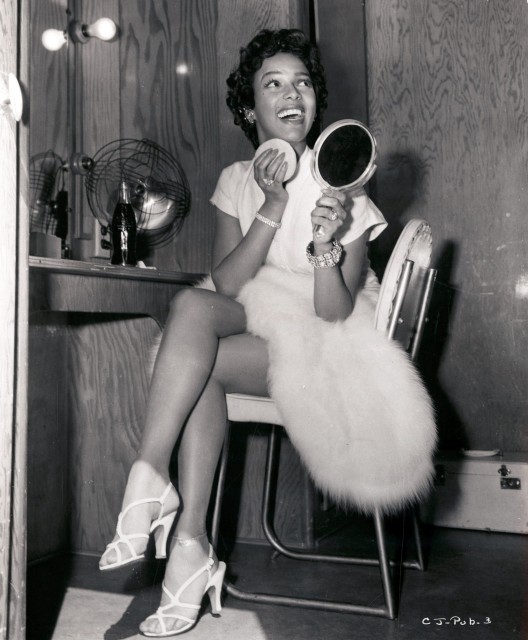
I look at the pictures of Dandridge in her prime, and I see someone who thinks she’s on the cusp of something big. That the world was going to accept her on her merit. That things were going to change. I look at that hope, and I feel terrible sadness. The real tragedy of the story of Dorothy Dandridge, then, is the tragedy of enduring, unspoken, insidious prejudice.
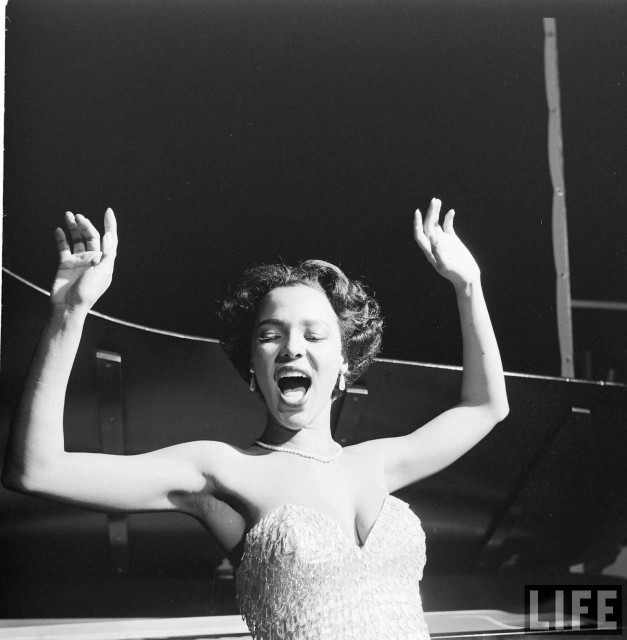
Previously: That Divine Gary Cooper
Anne Helen Petersen is a Doctor of Celebrity Gossip. No, really. You can find evidence (and other writings) here.